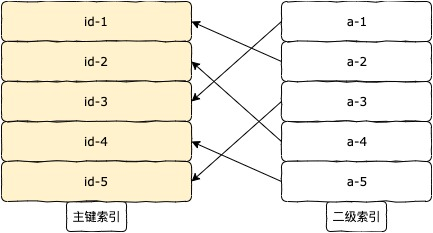mysql ---- limit使用方式
随着偏移量的增加,limit语句的执行会更加耗时,那么这是为什么呢?
随着偏移量的增加,limit语句的执行会更加耗时,那么这是为什么呢?
在业务中实现分页功能就离不了MySQL的limit语句,而随着数据表中数据量的增加,则不可避免会导致查询时偏移量过大。
我们知道随着偏移量的增大,limit语句的耗时会增加,接下来我们就探讨下如何去更好的处理limit的耗时问题。
一、实验
1、MySQL版本:
mysql> select version();
+-----------+
| version() |
+-----------+
| 8.0.18 |
+-----------+
1 row in set (0.00 sec)
2、实验表结构:
mysql> desc t213;
+-------+------------------+------+-----+---------+----------------+
| Field | Type | Null | Key | Default | Extra |
+-------+------------------+------+-----+---------+----------------+
| id | int(10) | NO | PRI | NULL | auto_increment |
| a | int(10) unsigned | NO | MUL | 0 | |
| b | int(10) unsigned | NO | | 0 | |
+-------+------------------+------+-----+---------+----------------+
3 rows in set (0.00 sec)
其中,id为自增主键,字段a为普通索引
3、实验数据量近200万:
mysql> select count(*) from t213;
+----------+
| count(*) |
+----------+
| 1979311 |
+----------+
1 row in set (0.11 sec)
4、开始测试:
当偏移量为100万时:
mysql> select * from t213 where a=4 limit 1000000,10;
+---------+---+-----+
| id | a | b |
+---------+---+-----+
| 1000001 | 4 | 123 |
| 1000002 | 4 | 123 |
| 1000003 | 4 | 123 |
| 1000004 | 4 | 123 |
| 1000005 | 4 | 123 |
| 1000006 | 4 | 123 |
| 1000007 | 4 | 123 |
| 1000008 | 4 | 123 |
| 1000009 | 4 | 123 |
| 1000010 | 4 | 123 |
+---------+---+-----+
10 rows in set (2.00 sec)
我们知道以上的方法效率并不高,一般我们在数据量大的数据表中,不直接limit,而是通过连接去先查询id,再查询字段:
mysql> select c1.id, c1.a, c1.b from t213 c1 right join(select id from t213 where a=4 limit 1000000,10)c2 on c1.id=c2.id;
+---------+------+------+
| id | a | b |
+---------+------+------+
| 1000001 | 4 | 123 |
| 1000002 | 4 | 123 |
| 1000003 | 4 | 123 |
| 1000004 | 4 | 123 |
| 1000005 | 4 | 123 |
| 1000006 | 4 | 123 |
| 1000007 | 4 | 123 |
| 1000008 | 4 | 123 |
| 1000009 | 4 | 123 |
| 1000010 | 4 | 123 |
+---------+------+------+
10 rows in set (0.16 sec)
这两种方法的效率相差巨大,那么为什么会如此呢?MySQL是如何执行相差巨大的两条语句的呢?
二、分析
根据高性能MySQL中关于limit的说明:
limit语句在偏移量巨大时,如select * from t213 where a=4 limit 1000000,10;。
对效率的影响主要在于MySQL会查询1,000,010条数据,并取最后10条,抛弃掉前面的1,000,000条。
也就是说,MySQL耗时耗力找到的数据,绝大部分都得废弃!
MySQL查找索引a的二级索引树,然后根据二级索引树上的主键值回表到聚簇索引树上进行扫描数据,为了limit而重复大量无用的IO操作

关于MySQL为什么limit时会遍历这么多数据,而不是遍历所需的几条,我们不去深究其设计原理,我们只分析下:
select c1.id, c1.a, c1.b from t213 c1 right join(select id from t213 where a=4 limit 1000000,10)c2 on c1.id=c2.id;
语句为何会比
select * from t213 where a=4 limit 1000000,10;
快那么多。
我们知道,MySQL中查询的数据会放在数据页中以便快速获取,
而系统表information_schema.innodb_buffer_page保存着InnoDB缓冲池中每个页面的信息。
我们在执行sql后查询innodb_buffer_page表中数据页的个数来判断下两个sql语句的不同之处。
t213表中有近200万数据
首先,重启MySQL服务,以便innodb_buffer_page表中t213测试表的数据页为空,然后执行不优化的sql:
mysql> select index_name,count(*) from information_schema.innodb_buffer_page
-> where index_name in('a','primary') and table_name like '%t213%' group by index_name;
Empty set (0.07 sec)
mysql> select * from test.t213 where a=4 limit 1000000,10;
+---------+---+-----+
| id | a | b |
+---------+---+-----+
| 1000001 | 4 | 123 |
| 1000002 | 4 | 123 |
| 1000003 | 4 | 123 |
| 1000004 | 4 | 123 |
| 1000005 | 4 | 123 |
| 1000006 | 4 | 123 |
| 1000007 | 4 | 123 |
| 1000008 | 4 | 123 |
| 1000009 | 4 | 123 |
| 1000010 | 4 | 123 |
+---------+---+-----+
10 rows in set (3.29 sec)
mysql> select index_name,count(*) from information_schema.innodb_buffer_page
-> where index_name in('a','primary') and table_name like '%t213%' group by index_name;
+------------+----------+
| index_name | count(*) |
+------------+----------+
| a | 901 |
| PRIMARY | 2156 |
+------------+----------+
2 rows in set (0.04 sec)
可以看到select * from test.t213 where a=4 limit 1000000,10;语句使用到901个二级索引a的索引数据页,使用到2156个聚簇索引数据页。
然后我们再次重启MySQL服务,确保innodb_buffer_page是空的,并执行优化的sql:
mysql> select index_name,count(*) from information_schema.innodb_buffer_page
-> where index_name in('a','primary') and table_name like '%t213%' group by index_name;
Empty set (0.03 sec)
mysql> select * from test.t213 c1 right join(select id from test.t213 where a=4 limit 1000000,10)c2 on c1.id=c2.id;
+---------+------+------+---------+
| id | a | b | id |
+---------+------+------+---------+
| 1000001 | 4 | 123 | 1000001 |
| 1000002 | 4 | 123 | 1000002 |
| 1000003 | 4 | 123 | 1000003 |
| 1000004 | 4 | 123 | 1000004 |
| 1000005 | 4 | 123 | 1000005 |
| 1000006 | 4 | 123 | 1000006 |
| 1000007 | 4 | 123 | 1000007 |
| 1000008 | 4 | 123 | 1000008 |
| 1000009 | 4 | 123 | 1000009 |
| 1000010 | 4 | 123 | 1000010 |
+---------+------+------+---------+
10 rows in set (0.22 sec)
mysql> select index_name,count(*) from information_schema.innodb_buffer_page
-> where index_name in('a','primary') and table_name like '%t213%' group by index_name;
+------------+----------+
| index_name | count(*) |
+------------+----------+
| a | 901 |
| PRIMARY | 3 |
+------------+----------+
2 rows in set (0.04 sec)
以上可以看到优化后的sql使用了聚簇索引树的3个数据页。
通过两个对比,我们可以发现,在
select * from test.t213 c1 right join(select id from test.t213 where a=4 limit 1000000,10)c2 on c1.id=c2.id;
语句中,首先执行关联语句 select id from test.t213 where a=4 limit 1000000,10
使用到覆盖索引的概念,扫描二级索引树并获取到主键id值。
之后执行外部sql时,由于id已经找到,直接回表聚簇索引树查找响应id数据即可。
而执行未优化的select * from test.t213 where a=4 limit 1000000,10;语句时,
每一次在二级索引获取到的id值都需要回表,执行到最后才判断哪些数据是满足条件的,这样导致费力不讨好,效率很慢。
三、总结
高性能MySQL中提供有以下几种limit分页的优化方式:
1、join关联方式:select * from test.t213 c1 right join(select id from test.t213 where a=4 limit 1000000,10)c2 on c1.id=c2.id;
2、主键递增的表,每次分页记录上次的最大id值,下次分页查询通过判断id > last_id_num来执行:select * from test.t213 where id>1000000 and a=4 limit 10;
3、主键递增的表,通过between id值来执行分页:select * from test.t213 where a=4 and id between 1000001 and 1000010;
一般来说2,3两种方法虽然效率更高,但是局限性稍大。
实际项目中,针对分页我们要注意,随着数据量的增加,如果limit使用不当,分页效率会越来越慢,导致接口响应时间增加,用户友好度下降。
编写sql时使用合适的limit方式,会减少很多不必要的问题。


 浙公网安备 33010602011771号
浙公网安备 33010602011771号